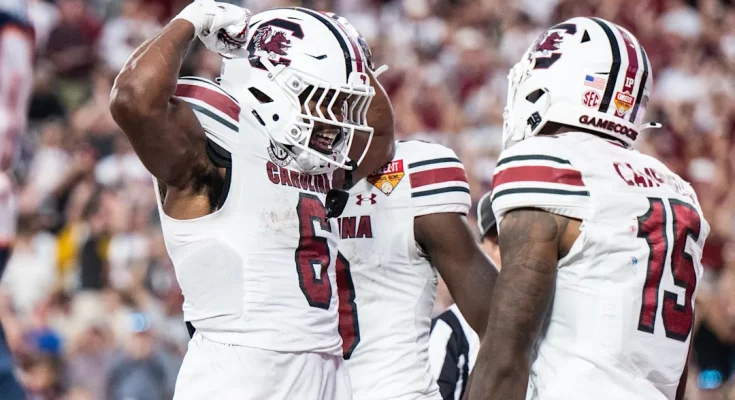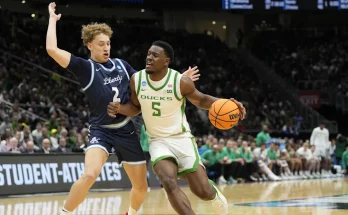When the face of a football program’s past returns to shape its future, it’s more than just a reunion—it’s a message. That message echoed across the turf when former No. 1 NFL draft pick and South Carolina legend Jadeveon Clowney was seen working closely with rising Gamecocks EDGE rusher Dylan Stewart, the prized five-star freshman already drawing buzz for his freakish athleticism and pro-caliber potential. For fans, teammates, and coaches alike, the sight of Clowney offering hands-on mentorship to Stewart wasn’t just a feel-good offseason moment—it was a symbolic passing of the torch and a glimpse at what could be another dominant defensive force brewing in Columbia.
Clowney’s presence alone carries gravity. The Rock Hill native was a generational recruit who lived up to his billing at South Carolina, becoming one of the most feared defenders in college football history. His explosive plays—none more iconic than his helmet-jarring hit on Michigan’s Vincent Smith in the 2013 Outback Bowl—are etched into Gamecock lore. He left Columbia as a top draft pick, an All-American, and the gold standard for what an EDGE rusher at South Carolina could become. So when he returns to campus, people pay attention.
What makes his recent session with Stewart even more significant is the timing. Stewart, a product of Washington, D.C., was among the most coveted prospects in the 2024 recruiting cycle. At 6-foot-5 and hovering near 240 pounds with eye-popping explosiveness off the edge, Stewart was widely seen as the crown jewel of Shane Beamer’s recruiting efforts. Landing him was a statement. Developing him into the next Clowney-esque force would be a legacy-defining success for Beamer and defensive line coach Travian Robertson. That’s why Clowney’s willingness to invest time and energy into the young phenom speaks volumes. It isn’t just about football; it’s about identity, legacy, and instilling a winning culture rooted in dominance up front.
Observers at the session noted Clowney wasn’t merely offering platitudes or standing in for a photo-op. He was locked in. He worked on Stewart’s stance, hand placement, leverage, and timing off the snap. The veteran edge rusher demonstrated how to explode through blocks with better pad level and gave pointers on using the long arm and rip techniques that served him well throughout his NFL career. Clowney’s teaching was practical, intense, and personalized. He wasn’t just sharing tips—he was transferring knowledge earned through a decade of trench warfare in the league. For Stewart, the opportunity to learn from someone who’s walked the same path and dominated at every level is priceless.
This mentorship isn’t just symbolic—it could have tangible on-field implications. Stewart is expected to compete for major snaps as a freshman, and if his development accelerates, he could become a pivotal part of Clayton White’s defense sooner rather than later. South Carolina has lacked a true game-wrecking EDGE since Clowney’s departure, though players like D.J. Wonnum and Kingsley Enagbare flashed promise in recent years. Stewart represents something different—a rare blend of size, speed, and instinct that’s reminiscent of Clowney’s dominance. The fact that Clowney sees enough in Stewart to mentor him suggests the former star believes the young man has the tools to carry that torch forward.
From the coaching staff’s perspective, Clowney’s involvement is a dream scenario. Beamer has worked diligently to reconnect Gamecock legends with the current roster, creating a pipeline of leadership and pride that transcends generations. Inviting Clowney back to work with Stewart was a stroke of genius, but it’s also the result of months of relationship-building and a shared vision for what South Carolina football can become again. Clowney has remained publicly supportive of the program but hadn’t taken such a hands-on role until now. His decision to mentor Stewart is a powerful endorsement of Beamer’s vision and the direction of the program.
For Stewart, the mentorship could serve as a defining moment. Recruited with the expectation of being a future NFL player, he now has access to a blueprint that few others can replicate. Clowney knows the pressures, the expectations, the weight of being “the guy” in Columbia. He can speak directly to what it takes to thrive at South Carolina, not just in terms of technique, but in navigating the mental and emotional challenges that come with stardom. That kind of guidance, especially so early in Stewart’s college career, could provide a competitive edge both on and off the field.
Stewart has already drawn praise from teammates and coaches for his work ethic and maturity. He enrolled early and hit the ground running in spring practice, absorbing the playbook and attacking each rep with urgency. Defensive line coach Travian Robertson has praised his coachability and drive, noting that Stewart is “hungry to be great” and “doesn’t act like a freshman.” Those traits made him a fit for this type of elite mentorship. Clowney wouldn’t waste his time on someone who wasn’t serious about the craft. By investing in Stewart, he’s signaling belief in the young man’s character as much as his talent.
It’s also worth noting that Stewart’s recruitment and arrival are emblematic of South Carolina’s rise on the national recruiting stage under Beamer. The Gamecocks went toe-to-toe with powerhouses like Georgia, Ohio State, and Alabama to land Stewart, and they won. That victory wasn’t just about NIL or flashy pitches—it was about culture, fit, and the chance to make history. Now, with Clowney stepping in to help polish one of the program’s most promising assets, it becomes clear that South Carolina isn’t just collecting talent—they’re cultivating it with intent.
The ripple effects of Clowney’s mentorship might not be fully visible until fall Saturdays, but make no mistake: moments like this matter. They build belief. They reinforce standards. They create continuity between generations of athletes who bleed garnet and black. Stewart isn’t just being prepared to play—he’s being shaped to lead. And having someone like Clowney in his corner? That accelerates everything.
As the 2025 season approaches, Stewart will have every chance to make a name for himself. With veteran EDGE players like Jatius Geer and Tyreek Johnson in the mix, the defensive front has a blend of experience and youth that could pose problems for SEC offenses. Stewart doesn’t have to be the guy right away—but all signs point to him becoming the guy sooner than most expect. If he starts stringing together dominant performances, don’t be surprised if we start hearing whispers of “Clowney 2.0.” And if that happens, it won’t be by accident. It’ll be the result of hard work, elite coaching, and a mentor who once stood in his shoes and left a legacy now waiting to be extended.
In the end, Clowney’s return to Columbia is more than a story about drills or technique—it’s a story about belief. Belief in the next generation. Belief in the program. Belief that South Carolina can rise again, powered by homegrown talent, relentless work, and legends who refuse to let their legacy fade quietly into the past. Dylan Stewart doesn’t have to fill Clowney’s shoes—not yet. But under Clowney’s watchful eye, he might just build a pair of his own, custom fit for a new era of Gamecock dominance.



